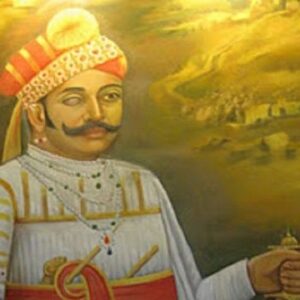Maharana Sangram Singh, colloquially referred to as Rana Sanga, was the monarch of Mewar and one of the most renowned Rajput leaders in sixteenth-century India. He was a Rajput of the Sisodiya clan and ruled between 1508 and 1528. He is renowned for his bravery and the way he resisted the Mughal invader Babur. He succeeded in the kingdom following his father’s death following a protracted power struggle with his brothers. He reigned during a period of great upheaval in Indian history. The Rajput dynasty was renowned for its valiant warriors and strongholds across the Indian subcontinent. Throughout the sixteenth century, the Rajput dynasty challenged all of India’s non-Indian Muslim kingdoms. Rana Sanga consolidated his power in Mewar after rising to the throne and began his campaign against the invading Muslims. Sanga fought invading troops and took control of Malwa with the assistance of Rajput rebels. He then shifted his focus to north-eastern Rajasthan, which was then controlled by Ibrahim Lodi. Sanga sustained severe injuries during the conflicts between the Rajputs and Lodi’s forces, yet he beat Lodi on numerous occasions. As his influence rose, battle with the Mughals seemed inevitable, and Sanga was beaten and killed by Babur in the Battle of Khanwa.
Childhood & Adolescence
Sangram Singh was born in Malwa, Rajasthan, India, on 12 April 1484 to Rana Raimal, a Rajput lord of Mewar. He was a Rajput from the Sisodiya clan. He had a number of brothers.
Accession to the Throne and Reign
In 1508, Rana Sanga replaced his father, Rana Raimal, as king of Mewar, after a bloody power battle with his siblings. He immediately began solidifying his influence in Mewar upon assuming the throne.
After establishing a stronghold in Mewar, he shifted his focus to the troubled neighboring kingdom of Malwa, which was racked by internal strife. Mehmood Khilji, the king of Malwa, sought assistance from both Delhi’s Sultan Ibrahim Lodi and Gujarat’s Bahadur Shah. Medini Rai, his Rajput wazir, asked for Sanga’s assistance.
The protracted conflict between Mewar and North India’s Muslim sultans culminated in the Battle of Gagron. Sanga overcame Khilji and his allies during a series of bloody engagements. He imprisoned Khilji but eventually released him in exchange for hosting his sons at Mewar’s capital, Chittor. Thus, Rana Sanga conquered Malwa.
Rana Sanga established himself as a formidable monarch following his conquest of Malwa. He grew increasingly ambitious and shifted his focus to north-eastern Rajasthan, which was then controlled by Lodi, Khilji’s ally. He invaded the region and succeeded in capturing several significant places, including the Ranthambore fort.
Lodi responded by invading Mewar. Sanga’s armies proved to be far too powerful for the ethnic Afghans of Lodi. Sanga lost his left arm and was paralyzed in one leg during the next fight, the Battle of Khatoli (Gwalior). However, the Rajputs were successful in acquiring territory.
After being humiliated in the Battle of Khatoli, Lodi faced Sanga again in the Battle of Dholpur and was defeated once more. After a few more battles, Sanga was able to take a large portion of present-day Rajasthan and greatly expand his kingdom.
He received widespread notoriety as his stature as a great monarch in India grew. Now a major actor in the power struggle for control of India’s northern provinces, he set his sights high and plotted the conquest of Delhi and the conquest of the entire country.
He then waged battle against Babur, the Mughal invader. He enlisted the assistance of others, including Raja Hasan Khan Mewati, Mehmud Lodi, and Raja Medini Rai of Alwar. In 1527, this combined troop confronted Babur’s army at Khanwa, near Fatehpur Sikri.
The conflict was bloody and acrimonious. Shade, one of Sanga’s allies, deserted the maharana at a critical point in the conflict. While Rana Sanga was attempting to reconstitute his army, he was wounded and fell from his horse unconscious. The Rajput army believed Sanga was dead and fled in fear. This resulted in the Mughals claiming victory.
Sanga’s devoted disciples escorted him to safety and saved his life. When the maharana regained his health, he determined to recover his realm from Babur. His nobles opposed his intentions for another battle with the mighty Mughals, and it is suspected that they poisoned Sanga in protest.
His Significant Battles
Rana Sanga’s victory over Ibrahim Lodi in the Battle of Khatoli was a tremendous win for the Rajputs. The Maharana lost an arm in the combat due to a sword cut and was rendered permanently lame due to an arrow wounded, yet this did not hinder his spirit in the least. Soon after, the Battle of Dholpur took place against the same foe, and Sanga beat Lodi and gained the majority of modern-day Rajasthan.
Sanga’s most famous engagement was the Battle of Khanwa, which pitted him against the first Mughal Emperor Babur. Sanga’s army was crushed in the fight, cementing the new Mughal monarchy in India.
Personal History and Legacies
Rana Sanga was the father of Bhoj Raj, Ratan Singh II, Vikramaditya Singh, and Udai Singh II. He was married to Rani Karnavati.
He was 43 years old when he died on 30 January 1528. He is thought to have been poisoned by a member of his noble family.
Estimated Net worth
unknown.


